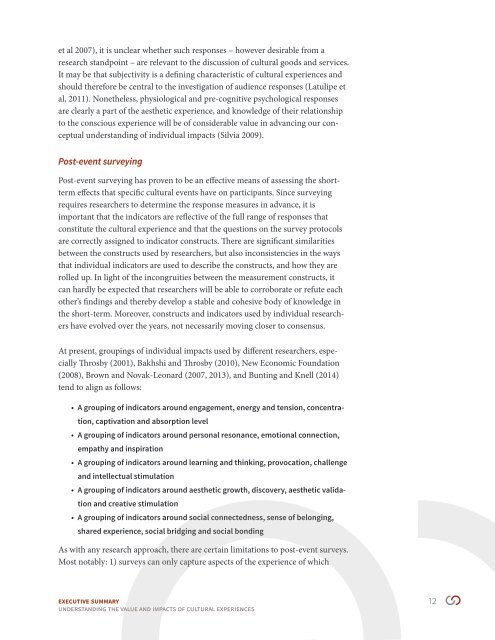aceUVi
aceUVi
aceUVi
Create successful ePaper yourself
Turn your PDF publications into a flip-book with our unique Google optimized e-Paper software.
et al 2007), it is unclear whether such responses – however desirable from a<br />
research standpoint – are relevant to the discussion of cultural goods and services.<br />
It may be that subjectivity is a defining characteristic of cultural experiences and<br />
should therefore be central to the investigation of audience responses (Latulipe et<br />
al, 2011). Nonetheless, physiological and pre-cognitive psychological responses<br />
are clearly a part of the aesthetic experience, and knowledge of their relationship<br />
to the conscious experience will be of considerable value in advancing our conceptual<br />
understanding of individual impacts (Silvia 2009).<br />
Post-event surveying<br />
Post-event surveying has proven to be an effective means of assessing the shortterm<br />
effects that specific cultural events have on participants. Since surveying<br />
requires researchers to determine the response measures in advance, it is<br />
important that the indicators are reflective of the full range of responses that<br />
constitute the cultural experience and that the questions on the survey protocols<br />
are correctly assigned to indicator constructs. There are significant similarities<br />
between the constructs used by researchers, but also inconsistencies in the ways<br />
that individual indicators are used to describe the constructs, and how they are<br />
rolled up. In light of the incongruities between the measurement constructs, it<br />
can hardly be expected that researchers will be able to corroborate or refute each<br />
other’s findings and thereby develop a stable and cohesive body of knowledge in<br />
the short-term. Moreover, constructs and indicators used by individual researchers<br />
have evolved over the years, not necessarily moving closer to consensus.<br />
At present, groupings of individual impacts used by different researchers, especially<br />
Throsby (2001), Bakhshi and Throsby (2010), New Economic Foundation<br />
(2008), Brown and Novak-Leonard (2007, 2013), and Bunting and Knell (2014)<br />
tend to align as follows:<br />
• A grouping of indicators around engagement, energy and tension, concentration,<br />
captivation and absorption level<br />
• A grouping of indicators around personal resonance, emotional connection,<br />
empathy and inspiration<br />
• A grouping of indicators around learning and thinking, provocation, challenge<br />
and intellectual stimulation<br />
• A grouping of indicators around aesthetic growth, discovery, aesthetic validation<br />
and creative stimulation<br />
• A grouping of indicators around social connectedness, sense of belonging,<br />
shared experience, social bridging and social bonding<br />
As with any research approach, there are certain limitations to post-event surveys.<br />
Most notably: 1) surveys can only capture aspects of the experience of which<br />
Executive Summary 12<br />
UNDERSTANDING the value and impacts of cultural experiences


